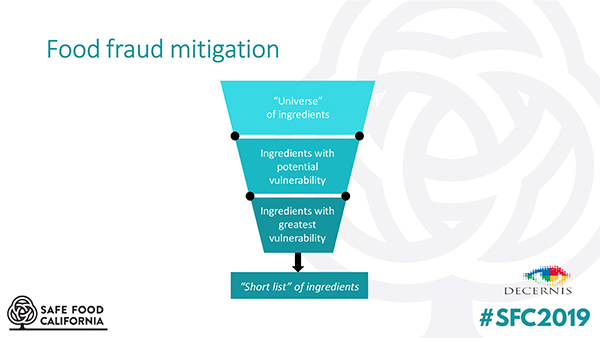Food supply chains are becoming more complex, as food companies are increasingly faced with blind spots such as deviations from required environmental conditions, theft, fraud and poor handling. Supply chains are global; transit routes that involve road, rail, sea and air create many potential points of failure in food safety or product integrity protocol that, until recently, were largely outside a company’s control.
Learn more about how to address risks in your supply chain at the Food Safety Supply Chain Conference | May 29–30, 2019 | Rockville, MD (or attend virtually)To maintain product quality and safety, companies should implement an environmental monitoring (EM) solution that paints a complete picture of their food products as they move through the supply chain. EM solutions that utilize devices powered by the Internet of Things (IoT) allow real-time tracking of cargo and provide actionable data that can mitigate common problems, change outcomes, and protect brands and consumer health.
Let’s take a deeper look into the problems that food manufacturers and distributors are facing how EM solutions can minimize or eliminate them altogether.
Current Hurdles for Food Supply Chains
As the global network of food trade expands, the diverse challenges facing suppliers, manufacturers, distributors and logistics companies present even more of a threat to supply chains and revenue.
According to PwC agribusiness advisory partner, Greg Quinn, worldwide food fraud results in losses of at least $65 billion a year. Luxury products such as Japanese Wagyu beef and Italian olive oil are regularly counterfeited and incorrectly labeled, and buyers often have no way to trace the origins of what they are purchasing.
Companies in the food and beverage industry also face diversion and theft, which can happen at any of the many blind spots along the supply chain. In fact, food and beverages were among the top commodities targeted by thieves in North America last year, accounting for 34% of all cargo theft, according to a report by BSI Supply Chain Services and Solutions.
Food product quality and safety are also seriously compromised when cargo is poorly handled while in transit, with hazards such as exposure to water, heat and cold, or substance contamination. These types of damages can be particularly acute in the cold chain, where perishable products must be moved quickly under specific environmental conditions, including temperature, humidity and light.
Furthermore, inefficiencies in routing—from not adhering to transport regulations to more basic oversights such as not monitoring traffic or not utilizing GPS location tracking—delay shipments, can result in product spoilage and/or shortened shelf life, and cost companies money. Routing and EM have become more important in light of FSMA, which FDA designed to better protect consumers by strengthening food safety systems for foodborne illnesses.
In short, businesses that manage food supply chains need to be on top of their game to guarantee product quality and safety and care for their brand.
How Does Product Tracking Technology Work?
Real-time EM solutions are proving to be an invaluable asset for companies seeking to combat supply chain challenges. Such product tracking capabilities give companies a vibrant and detailed picture of where their products are and what is happening to them. With EM in the supply chain, IoT technology is the crucial link to continuity, visibility and productivity.
So, how does integrated EM work? Sensors on pallets, cases or containers send data over communication networks at regular intervals. The data is made available via a software platform, where users can set parameters (e.g., minimum and maximum temperature) to alert the system of irregularities or generate reports for analysis. This data is associated with the traceability data and becomes part of a product’s pedigree, making it a powerful tool for supply chain visibility.
EM Combats Supply Chain Stumbling Blocks
EM allows companies to monitor their supply chain, protect consumers and realize considerable return on investment. The technology can show companies how to maximize route efficiencies, change shippers, or detect theft or diversion in real time. Tracking solutions transmit alerts, empowering manufacturers and suppliers to use data to halt shipments that may have been adulterated, redirect shipments to extend shelf life, and manage food recalls—or avoid them altogether. Recalls are a particularly important consideration: One 2012 study concluded that the average direct cost of a recall in the United States was $10 million.
The IoT-enabled technology provides real-time information about how long an item has been in transit, if the vehicle transporting it adhered to the approved route, and, if the shipment stopped, where and for how long. This is crucial information, especially for highly perishable goods. For example, leafy greens can be ruined if a truck’s engine and cooling system are turned off for hours at a border crossing. With EM and tracking, businesses are able to understand and act upon specific risks using detailed, unit-level data.
For example, a company can find out if pallets have dislodged, fallen, or have been compromised in other ways while in transit. They can receive alerts if the doors of a truck are opened at an unscheduled time or location, which could indicate theft. Thieves target food cargo more often than other products because it’s valuable, easy to sell and perishable, and evidence of the theft does not last very long. In fact, the U.S. Federal Bureau of Investigation estimates that cargo theft costs U.S. businesses $30 billion each year, with food and beverage being one of the primary targets. Businesses need to get smart about preventative actions.
All of this actionable data is available in real time, allowing businesses to make decisions immediately, not after the fact when it’s too late. When necessary, they can divert or reroute shipments or take actions to remedy temperature excursions and other environmental concerns. This saves money and protects their reputation. Furthermore, third-party logistics firms and contracted delivery companies can be held accountable for incidents and inefficiencies.
Conclusion
As the benefits of global supply chains have grown, so have the risks. With the FSMA shifting responsibility for safety to food companies, real-time EM is a vital step to ensure cargo is maintained in the correct conditions, remains on track to its destination, and is safeguarded from theft and fraud. With the advent of IoT-enabled tracking and EM technologies, supply chain operations can be streamlined and companies can prevent waste and financial losses, protect their investments and brand identity, and gain an advantage in the marketplace.















